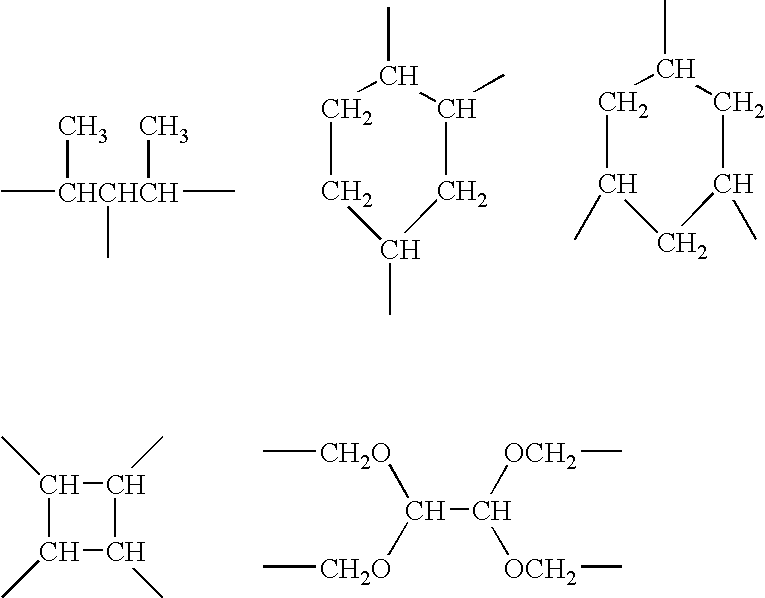Branched siloxane polymers comprising alkenyl groups and used as antimisting additives for silicone coating compositions
a technology of branched siloxane polymers and alkenyl groups, which is applied in the direction of coatings, etc., can solve the problems of complicated synthesizing and serious problems such as spray mist formation, and achieve the effects of reducing aerosol formation, rapid coating operation, and easy miscibility
- Summary
- Abstract
- Description
- Claims
- Application Information
AI Technical Summary
Benefits of technology
Problems solved by technology
Method used
Image
Examples
example 1
[0135]244 g of a linear α,ω-divinylpolydimethylsiloxane having an iodine number of 4.2 are mixed homogeneously with 0.35 g of a copolymer comprising dimethylsiloxy-, hydromethylsiloxy and trimethylsiloxy units, containing 0.72% by weight of Si-bonded hydrogen and having a viscosity of 64 mm2 / s at 25° C. (C═C / SiH=16). Thereafter 0.21 g of a 1.15% by weight strength (based on elemental platinum) solution of a platinum-1,3-divinyl-1,1,3,3-tetramethyldisiloxane complex in an α,ω-divinyldimethyl-polysiloxane having a viscosity of 1000 mPa·s at 25° C., a solution of the Karstedt catalyst (whose preparation is described in U.S. Pat. No. 3,775,452), as it is known, is added and the reaction mixture is heated to 50° C. Over the course of two hours the viscosity of the mixture increases from 490 mm2 / s to 830 mm2 / s at 25° C. The product is colorless and clear and has a vinyl equivalent weight of 6470 g / mol C═C.
example 2
[0136]In deviation from Example 1 a branched siloxane polymer with longer arm segments is prepared, by using, instead of the α,ω-divinylpolydimethylsiloxane with an iodine number of 4.2, a longer α,ω-divinylpolydimethylsiloxane having an iodine number of 1.43. The amount of the copolymer containing 0.72% by weight of Si-bonded hydrogen is reduced to 0.12 g (C═C / SiH=16). Following identical catalysis (as described in Example 1) with an analogous reaction course, a colorless, clear product is obtained, of 14,400 mm2 / S at 25° C. and a vinyl equivalent weight of 18,960 g / mol C═C.
example 3
[0137]The procedure of Example 1 is repeated with the modification that the amount of the α,ω-divinylpoly-dimethylsiloxane is reduced to 63% of the amount used there (C═C / SiH=10). After the end of the reaction a clear colorless product is obtained which has a viscosity of 1270 mm2 / s at 25° C. and thus is substantially more viscous than the product of Example 1. The vinyl equivalent weight is now 6740 g / mol C═C. Although the product is constructed from the identical structural elements as in Example 1, it has a substantially higher degree of branching by comparison.
[0138]Comparative Experiment 1 in accordance with WO 01 / 98420
[0139]The procedure of Example 3 is repeated with the modification that, instead of the linear α,ω-divinylpoly-dimethylsiloxane with an iodine number of 4.2, 80 g of a vinyl-terminal polydimethylsiloxane branched via MeSiO3 / 2 groups (Me=methyl radical) are used, having a viscosity of 380 mm2 / s at 25° C. and an iodine number of 8.1. This polymer contains on averag...
PUM
| Property | Measurement | Unit |
|---|---|---|
| Fraction | aaaaa | aaaaa |
| Fraction | aaaaa | aaaaa |
| Fraction | aaaaa | aaaaa |
Abstract
Description
Claims
Application Information
 Login to View More
Login to View More - R&D Engineer
- R&D Manager
- IP Professional
- Industry Leading Data Capabilities
- Powerful AI technology
- Patent DNA Extraction
Browse by: Latest US Patents, China's latest patents, Technical Efficacy Thesaurus, Application Domain, Technology Topic, Popular Technical Reports.
© 2024 PatSnap. All rights reserved.Legal|Privacy policy|Modern Slavery Act Transparency Statement|Sitemap|About US| Contact US: help@patsnap.com










